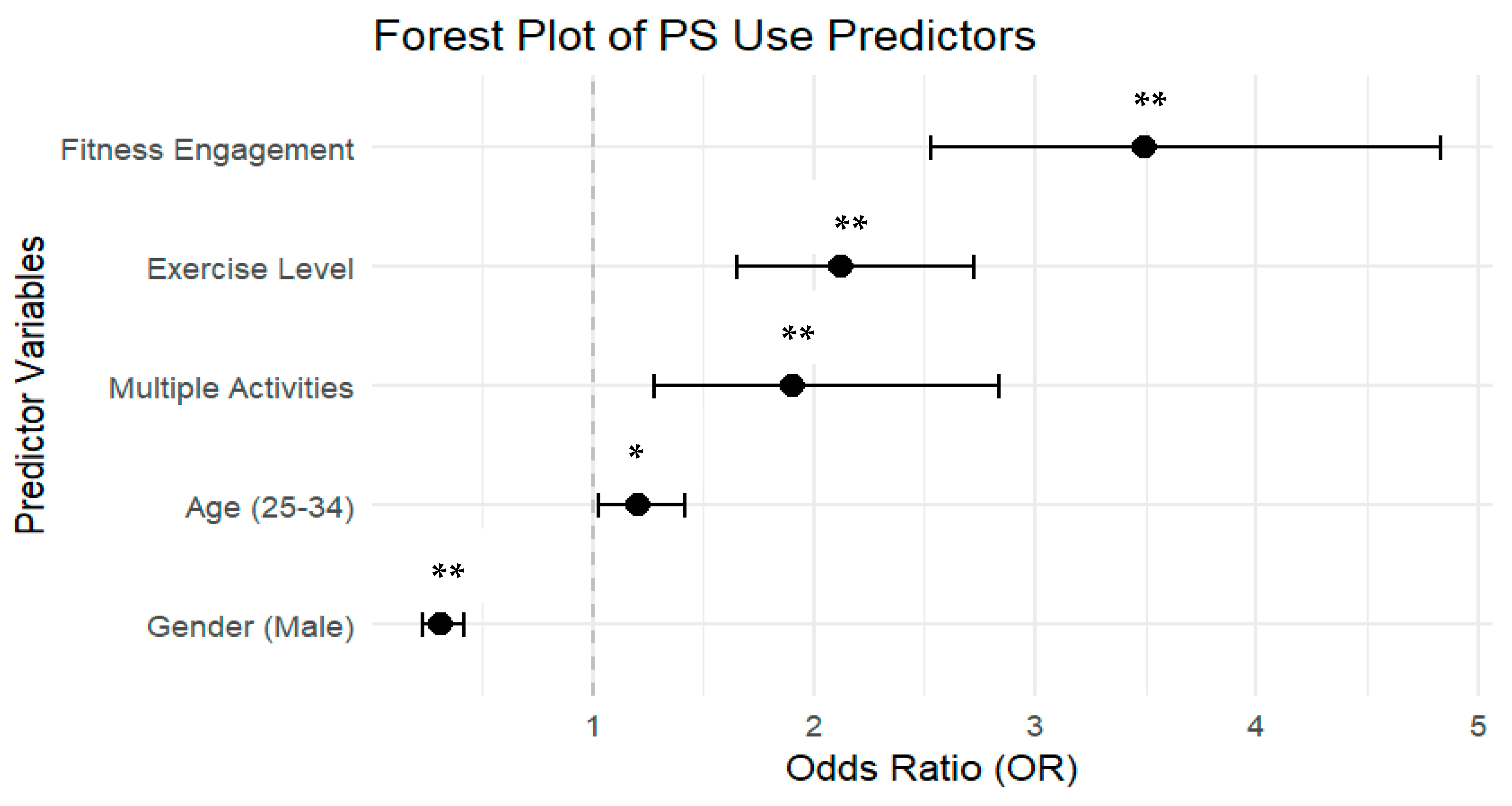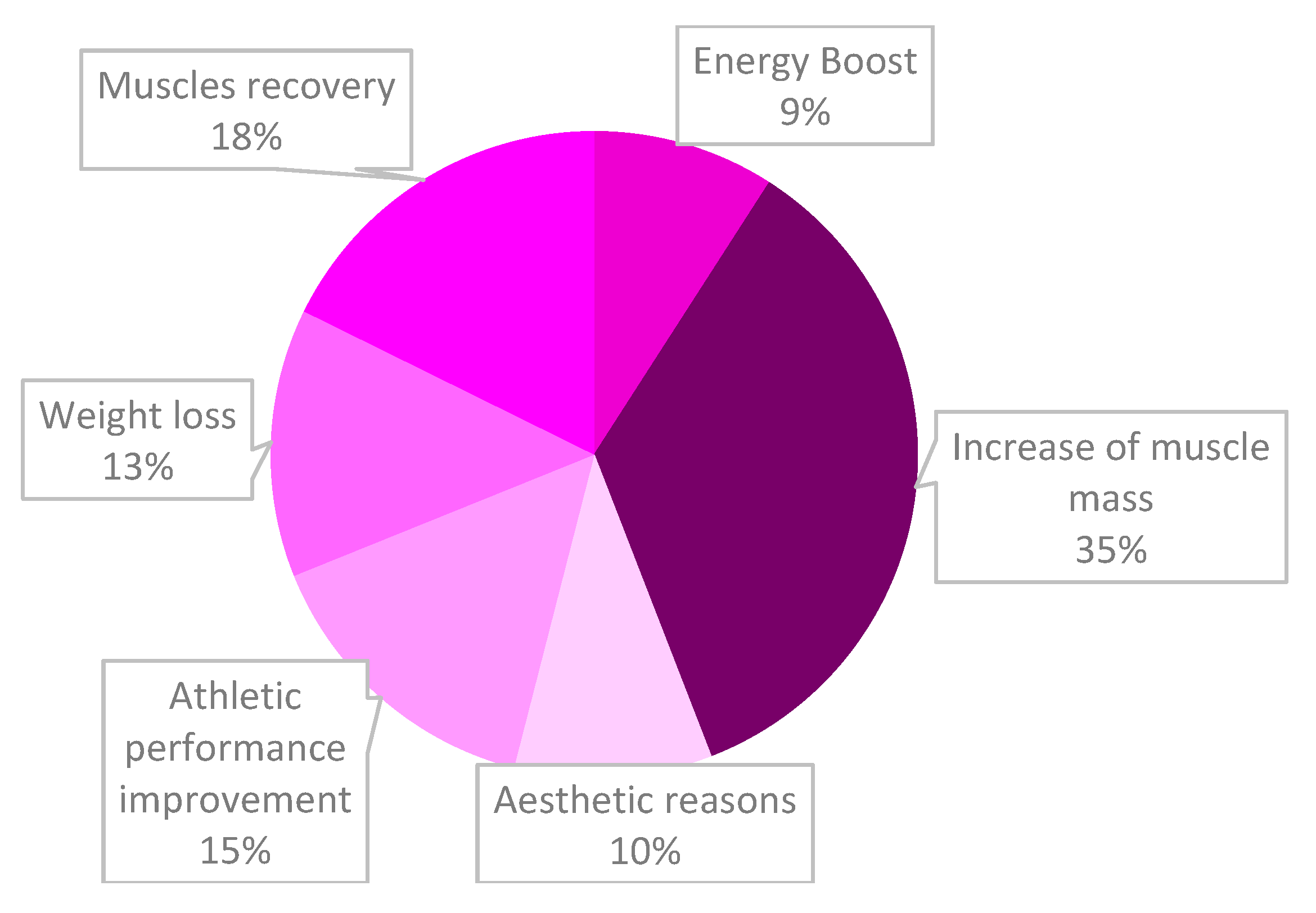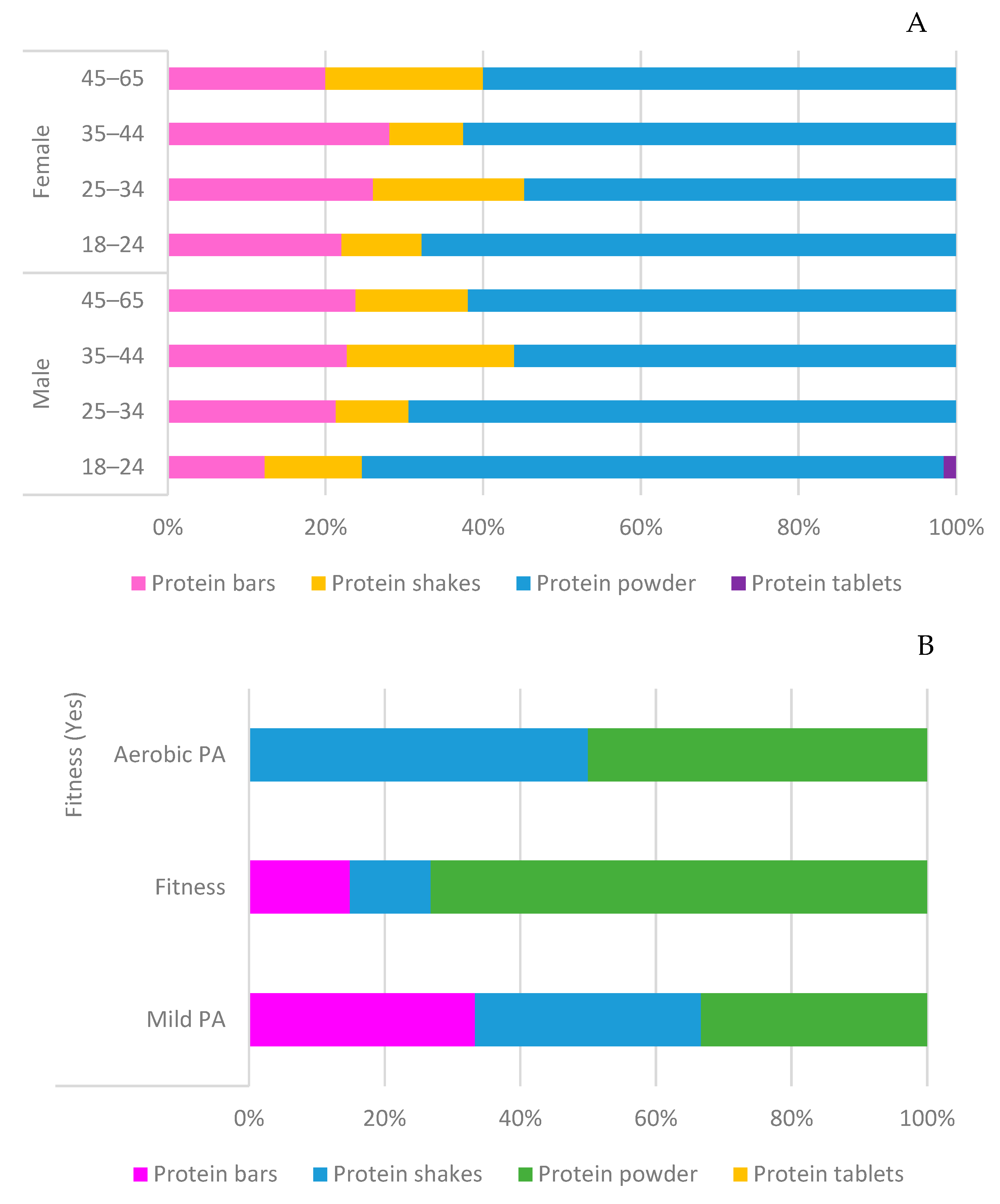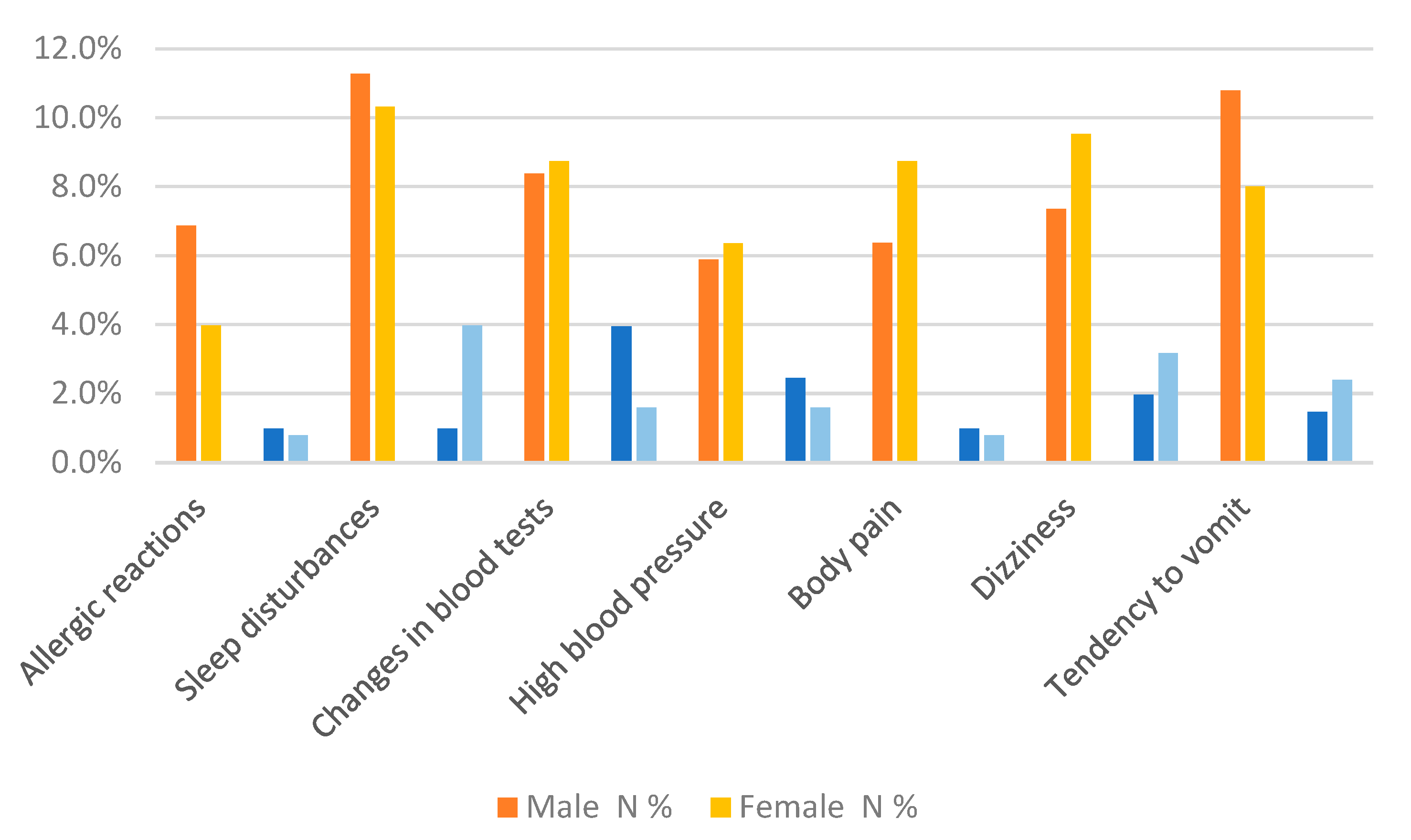Trends in Protein Supplement Use Among Non-Professional Athletes: Insights from a Survey in Greece
Abstract
1. Introduction
2. Results
2.1. Demographic Characteristics of Participants
2.2. Responses for PS Use by Non-Professional Athletes
3. Discussion
4. Materials and Methods
4.1. Study Design and Ethics
4.2. Eligibility Criteria of Participants
4.3. Statistical Analysis
5. Conclusions
Author Contributions
Funding
Institutional Review Board Statement
Informed Consent Statement
Data Availability Statement
Conflicts of Interest
References
- Mazzilli, M.; Macaluso, F.; Zambelli, S.; Picerno, P.; Iuliano, E. The Use of Dietary Supplements in Fitness Practitioners: A Cross-Sectional Observation Study. Int. J. Environ. Res. Public Health 2021, 18, 5005. [Google Scholar] [CrossRef] [PubMed]
- Doma, K.; Singh, U.; Boullosa, D.; Connor, J.D. The Effect of Branched-Chain Amino Acid on Muscle Damage Markers and Performance Following Strenuous Exercise: A Systematic Review and Meta-Analysis. Appl. Physiol. Nutr. Metab. 2021, 46, 1303–1313. [Google Scholar] [CrossRef]
- Pasiakos, S.M.; Lieberman, H.R.; McLellan, T.M. Effects of Protein Supplements on Muscle Damage, Soreness and Recovery of Muscle Function and Physical Performance: A Systematic Review. Sports Med. 2014, 44, 655–670. [Google Scholar] [CrossRef]
- Cintineo, H.P.; Arent, M.A.; Antonio, J.; Arent, S.M. Effects of Protein Supplementation on Performance and Recovery in Resistance and Endurance Training. Front. Nutr. 2018, 5, 400140. [Google Scholar] [CrossRef] [PubMed]
- Pearson, A.G.; Hind, K.; Macnaughton, L.S. The Impact of Dietary Protein Supplementation on Recovery from Resistance Exercise-Induced Muscle Damage: A Systematic Review with Meta-Analysis. Eur. J. Clin. Nutr. 2023, 77, 767–783. [Google Scholar] [CrossRef] [PubMed]
- Lipsky, L.M.; Nansel, T.R.; Haynie, D.L.; Liu, D.; Li, K.; Pratt, C.A.; Iannotti, R.J.; Dempster, K.W.; Simons-Morton, B. Diet Quality of US Adolescents during the Transition to Adulthood: Changes and Predictors. Am. J. Clin. Nutr. 2017, 105, 1424–1432. [Google Scholar] [CrossRef]
- Ormsbee, M.J.; Willingham, B.D.; Marchant, T.; Binkley, T.L.; Specker, B.L.; Vukovich, M.D. Protein Supplementation During a 6-Month Concurrent Training Program: Effect on Body Composition and Muscular Strength in Sedentary Individuals. Int. J. Sport Nutr. Exerc. Metab. 2018, 28, 619–628. [Google Scholar] [CrossRef]
- Poulios, A.; Georgakouli, K.; Draganidis, D.; Deli, C.K.; Tsimeas, P.D.; Chatzinikolaou, A.; Papanikolaou, K.; Batrakoulis, A.; Mohr, M.; Jamurtas, A.Z.; et al. Protein-Based Supplementation to Enhance Recovery in Team Sports: What Is the Evidence? J. Sports Sci. Med. 2019, 18, 523. [Google Scholar]
- Karpouzi, C.; Kosmidis, I.; Petridou, A.; Voulgaridou, G.; Papadopoulou, S.K.; Bogdanis, G.C.; Mougios, V. Effects of Protein Supplementation During High-Intensity Functional Training on Physical Performance in Recreationally Trained Males and Females: A Randomized Controlled Trial. Nutrients 2025, 17, 1441. [Google Scholar] [CrossRef]
- Karpouzi, C.; Kypraiou, A.; Mougios, V.; Petridou, A. Effects of Protein Supplementation during Pilates Training on Body Composition, Core Muscle Endurance, and Joint Flexibility in Trained Women: A Randomized Controlled Trial. J. Int. Soc. Sports Nutr. 2025, 22, 2472891. [Google Scholar] [CrossRef]
- Tsitsimpikou, C.; Chrisostomou, N.; Papalexis, P.; Tsarouhas, K.; Tsatsakis, A.; Jamurtas, A. The Use of Nutritional Supplements among Recreational Athletes in Athens, Greece. Int. J. Sport Nutr. Exerc. Metab. 2011, 21, 377–384. [Google Scholar] [CrossRef] [PubMed]
- Passariello, C.L.; Marchionni, S.; Carcuro, M.; Casali, G.; della Pasqua, A.; Hrelia, S.; Malaguti, M.; Lorenzini, A. The Mediterranean Athlete’s Nutrition: Are Protein Supplements Necessary? Nutrients 2020, 12, 3681. [Google Scholar] [CrossRef]
- de Oliveira, V.N.; Andrade, M.S.; Sinisgalli, R.; Vancini, R.L.; de Conti Teixeira Costa, G.; Weiss, K.; Knechtle, B.; de Lira, C.A.B. Prevalence of Dietary Supplement Use among Male Brazilian Recreational Triathletes: A Cross-Sectional Study. BMC Res. Notes 2024, 17, 8. [Google Scholar] [CrossRef] [PubMed]
- Baltazar-Martins, G.; Brito de Souza, D.; Aguilar-Navarro, M.; Muñoz-Guerra, J.; Plata, M.d.M.; Del Coso, J. Prevalence and Patterns of Dietary Supplement Use in Elite Spanish Athletes. J. Int. Soc. Sports Nutr. 2019, 16, 30. [Google Scholar] [CrossRef]
- Bandyopadhyay, K.; Ray, S.; Vashisht, S.; Bhalla, G.; Sarao, M. Knowledge and Practices about Protein Supplement Use amongst Students of a Medical College. J. Mar. Med. Soc. 2019, 21, 19. [Google Scholar] [CrossRef]
- Vasconcelos, Q.D.J.S.; Bachur, T.P.R.; Aragão, G.F. Whey Protein Supplementation and Its Potentially Adverse Effects on Health: A Systematic Review. Appl. Physiol. Nutr. Metab. 2021, 46, 27–33. [Google Scholar] [CrossRef]
- Holeček, M.; Holeček, M. Side Effects of Amino Acid Supplements. Physiol. Res. 2022, 71, 29–45. [Google Scholar] [CrossRef]
- Estévez, M.; Luna, C. Dietary Protein Oxidation: A Silent Threat to Human Health? Crit. Rev. Food Sci. Nutr. 2017, 57, 3781–3793. [Google Scholar] [CrossRef]
- Rodríguez-Romero, J.d.J.; Durán-Castañeda, A.C.; Cárdenas-Castro, A.P.; Sánchez-Burgos, J.A.; Zamora-Gasga, V.M.; Sáyago-Ayerdi, G.S. What We Know about Protein Gut Metabolites: Implications and Insights for Human Health and Diseases. Food Chem. X 2022, 13, 100195. [Google Scholar] [CrossRef]
- Turkez, H.; Geyikoglu, F.; Tatar, A.; Keles, M.S.; Kaplan, I. The Effects of Some Boron Compounds against Heavy Metal Toxicity in Human Blood. Exp. Toxicol. Pathol. 2012, 64, 93–101. [Google Scholar] [CrossRef]
- Lu, Y.; Liang, X.; Niyungeko, C.; Zhou, J.; Xu, J.; Tian, G. A Review of the Identification and Detection of Heavy Metal Ions in the Environment by Voltammetry. Talanta 2018, 178, 324–338. [Google Scholar] [CrossRef]
- Thakkar, S.; Anklam, E.; Xu, A.; Ulberth, F.; Li, J.; Li, B.; Hugas, M.; Sarma, N.; Crerar, S.; Swift, S.; et al. Regulatory Landscape of Dietary Supplements and Herbal Medicines from a Global Perspective. Regul. Toxicol. Pharmacol. 2020, 114, 104647. [Google Scholar] [CrossRef]
- Ruano, J.; Teixeira, V.H. Prevalence of Dietary Supplement Use by Gym Members in Portugal and Associated Factors. J. Int. Soc. Sports Nutr. 2020, 17, 11. [Google Scholar] [CrossRef]
- Finamore, A.; Benvenuti, L.; De Santis, A.; Cinti, S.; Rossi, L. Sportsmen’s Attitude towards Dietary Supplements and Nutrition Knowledge: An Investigation in Selected Roman Area Gyms. Nutrients 2022, 14, 945. [Google Scholar] [CrossRef] [PubMed]
- Wu, G. Dietary Protein Intake and Human Health. Food Funct. 2016, 7, 1251–1265. [Google Scholar] [CrossRef] [PubMed]
- Phillips, S.M. Protein Requirements and Supplementation in Strength Sports. Nutrition 2004, 20, 689–695. [Google Scholar] [CrossRef] [PubMed]
- Morton, R.W.; Murphy, K.T.; McKellar, S.R.; Schoenfeld, B.J.; Henselmans, M.; Helms, E.; Aragon, A.A.; Devries, M.C.; Banfield, L.; Krieger, J.W.; et al. A Systematic Review, Meta-Analysis and Meta-Regression of the Effect of Protein Supplementation on Resistance Training-Induced Gains in Muscle Mass and Strength in Healthy Adults. Br. J. Sports Med. 2018, 52, 376–384. [Google Scholar] [CrossRef]
- Ferrando, A.A.; Wolfe, R.R.; Hirsch, K.R.; Church, D.D.; Kviatkovsky, S.A.; Roberts, M.D.; Stout, J.R.; Gonzalez, D.E.; Sowinski, R.J.; Kreider, R.B.; et al. International Society of Sports Nutrition Position Stand: Essential Amino Acid Supplementation on Skeletal Muscle and Performance. J. Int. Soc. Sports Nutr. 2023, 20, 2263409. [Google Scholar] [CrossRef]
- Fiorini, S.; Neri, L.D.C.L.; Guglielmetti, M.; Pedrolini, E.; Tagliabue, A.; Quatromoni, P.A.; Ferraris, C. Nutritional Counseling in Athletes: A Systematic Review. Front. Nutr. 2023, 10, 1250567. [Google Scholar] [CrossRef]
- Ewan, T.; Bettina, K.; Fatma Nese, S.; Goktug, E.; Francesco, M.; Vincenza, L.; Antonio, P.; Paulo, G.; Antonio, P.; Antonino, B. Protein Supplement Consumption Is Linked to Time Spent Exercising and High-Protein Content Foods: A Multicentric Observational Study. Heliyon 2019, 5, e01508. [Google Scholar] [CrossRef]
- Saleh, K.K.; Julien, S.G. Protein Supplement Perceptions, Use, and Associated Performance in Young Lebanese Resistance-Training Athletes. J. Nutr. Metab. 2022, 2022, 4150620. [Google Scholar] [CrossRef] [PubMed]
- Knapik, J.J.; Steelman, R.A.; Hoedebecke, S.S.; Austin, K.G.; Farina, E.K.; Lieberman, H.R. Prevalence of Dietary Supplement Use by Athletes: Systematic Review and Meta-Analysis. Sports Med. 2016, 46, 103–123. [Google Scholar] [CrossRef]
- Wafi, A.M.; Alhazmi, O.A.; Jathmi, A.J.; Otaif, A.A.; Sharif, M.A.; Ismael, A.I.; Qadry, E.A.; Shaikh, A.Y.; Alfaify, F.H.; Jesudoss, H.J.; et al. Protein Supplement Intake by Non-Athlete Gym Attendees in Jazan Region: Misconceptions and Gender Differences. J. Sports Med. Phys. Fit. 2024, 64, 151–159. [Google Scholar] [CrossRef]
- Lacerda, F.M.M.; Carvalho, W.R.G.; Hortegal, E.V.; Cabral, N.A.L.; Veloso, H.J.F. Factors Associated with Dietary Supplement Use by People Who Exercise at Gyms. Rev. Saude Publica 2015, 49, 63. [Google Scholar] [CrossRef]
- Mohd Ashri, M.H.; Abu Saad, H.; Adznam, S.N.Ά. Socio-Demographic Characteristics, Body Weight Status and Energy Intake among Users and Non-Users of Dietary Supplements among Government Employees in Putrajaya, Malaysia. Nutrients 2021, 13, 2248. [Google Scholar] [CrossRef] [PubMed]
- Alhakbany, M.A.; Alzamil, H.A.; Alnazzawi, E.; Alhenaki, G.; Alzahrani, R.; Almughaiseeb, A.; Al-Hazzaa, H.M. Knowledge, Attitudes, and Use of Protein Supplements among Saudi Adults: Gender Differences. Healthcare 2022, 10, 394. [Google Scholar] [CrossRef]
- Aguilar-Navarro, M.; Baltazar-Martins, G.; Brito de Souza, D.; Muñoz-Guerra, J.; del Mar Plata, M.; Del Coso, J. Gender Differences in Prevalence and Patterns of Dietary Supplement Use in Elite Athletes. Res. Q Exerc. Sport 2021, 92, 659–668. [Google Scholar] [CrossRef] [PubMed]
- Katharina, W.; Mohamad, M.; Derrick, T.; Martina, G.; Gerold, W.; Claus, L.; Lee, H.; Thomas, R.; Beat, K. Supplement Intake in Half-Marathon, (Ultra-)Marathon and 10-Km Runners–Results from the NURMI Study (Step 2). J. Int. Soc. Sports Nutr. 2021, 18, 64. [Google Scholar] [CrossRef]
- Parnell, J.A.; Wiens, K.; Erdman, K.A. Evaluation of Congruence among Dietary Supplement Use and Motivation for Supplementation in Young, Canadian Athletes. J. Int. Soc. Sports Nutr. 2015, 12, 49. [Google Scholar] [CrossRef]
- Patel, V.; Aggarwal, K.; Dhawan, A.; Singh, B.; Shah, P.; Sawhney, A.; Jain, R. Protein Supplementation: The Double-Edged Sword. Bayl. Univ. Med. Cent. Proc. 2024, 37, 118–126. [Google Scholar] [CrossRef]
- Almudaihim, A.; Sudersanadas, K.; Abdelrahman, I.; Alkoblan, A.; Philip, W.; Tambur, P.; Alrabiah, S. Popularity and Perceptions of Protein Supplementation: A Cross-Sectional Study Among Undergraduate University Students Aged 18 to 25 Years in Riyadh, Saudi Arabia. Cureus 2024, 16, e75431. [Google Scholar] [CrossRef] [PubMed]
- Djaoudene, O.; Romano, A.; Bradai, Y.D.; Zebiri, F.; Ouchene, A.; Yousfi, Y.; Amrane-Abider, M.; Sahraoui-Remini, Y.; Madani, K. A Global Overview of Dietary Supplements: Regulation, Market Trends, Usage during the COVID-19 Pandemic, and Health Effects. Nutrients 2023, 15, 3320. [Google Scholar] [CrossRef] [PubMed]
- Bianco, A.; Mammina, C.; Paoli, A.; Bellafiore, M.; Battaglia, G.; Caramazza, G.; Palma, A.; Jemni, M. Protein Supplementation in Strength and Conditioning Adepts: Knowledge, Dietary Behavior and Practice in Palermo, Italy. J. Int. Soc. Sports Nutr. 2011, 8, 25. [Google Scholar] [CrossRef] [PubMed]
- Sánchez Oliver, A.; Miranda León, M.T.; Guerra-Hernández, E. Prevalence of Protein Supplement Use at Gyms. Nutr. Hosp. 2011, 26, 1168–1174. [Google Scholar] [CrossRef]





| Female | Male | |||
|---|---|---|---|---|
| Age (years) | ||||
| 18–24 | 149 (22.5) | 113 (25.5) | ||
| 25–34 | 253 (38.3) | 206 (46.9) | ||
| 35–44 | 79 (12.0) | 91 (20.7) | ||
| 45–65 | 46 (7.0) | 29 (6.6) | ||
| BMI (kg/m2) | ||||
| <18.4 | 32 (4.8) | 1 (0.2) | ||
| 18.5–24.9 | 483 (73.1) | 208 (47.4) | ||
| 25–29.9 | 112 (16.9) | 194 (44.2) | ||
| 30–34.9 | 28 (4.2) | 29 (6.6) | ||
| 35–39.9 | 6 (0.9) | 7 (1.6) | ||
| BMI (kg/m2) Mean ± SD | 22.5 ± 3.64 | 25.56 ± 3.34 | ||
| Protein Supplement Use, N (%) | ||||
| Total 1100 (100) | Yes 327 (30) | No 773 (70) | p-value | |
| Gender | <0.001 * | |||
| Male | 439 (40) | 203 (62) | 236 (31) | |
| Female | 661 (60) | 124 (38) | 537 (69) | |
| Age (years) | <0.001 * | |||
| 18–24 | 396 (36) | 98 (30) | 298 (39) | |
| 25–34 | 459 (42) | 136 (42) | 323 (42) | |
| 35–44 | 170 (15) | 71 (22) | 99 (13) | |
| 45–65 | 75 (7) | 22 (6) | 53 (6) | |
| BMI (kg/m2) | <0.001* | |||
| <18.4 | 33 (3) | 7 (2) | 26 (3) | |
| 18.5–24.9 | 691 (63) | 189 (58) | 502 (65) | |
| 25–29.9 | 306 (28) | 120 (36) | 186 (24) | |
| 30–34.9 | 57 (5) | 9 (3) | 48 (6) | |
| 35–39.9 | 13 (1) | 2 (1) | 11 (2) | |
| Education | 0.170 | |||
| Secondary | 404 (37) | 117 (36) | 287 (37) | |
| Undergraduate | 522 (47) | 148 (45) | 374 (48) | |
| Postgraduate | 174 (16) | 62 (19) | 112 (15) | |
| Work related to sports | <0.001 * | |||
| Yes | 262 (24) | 100(31) | 162 (21) | |
| No | 838 (76) | 227(69) | 611 (79) | |
| Smoking | 0.020 * | |||
| Yes | 378 (34) | 98 (30) | 280 (36) | |
| No | 722 (66) | 229 (70) | 493 (64) | |
| Energy_Increase | Mass_Increase | Aesthetics | Performance_Improvement | Weight_Loss | Muscle_Recovery | |
|---|---|---|---|---|---|---|
| Age_Groups | 0.065 | 0.063 | 0.086 | 0.097 | 0.109 | 0.183 |
| BMI_Groups | 0.116 | 0.114 | 0.055 | 0.202 | 0.167 | 0.155 |
| Gender | 0.023 | 0.068 | 0.021 | 0.058 | 0.035 | 0.047 |
| Age_25–34 | 0.180 | 0.120 | 0.170 | 0.160 | 0.200 | 0.120 |
| Age_35–44 | 0.300 | 0.270 | 0.110 | 0.330 | 0.280 | 0.280 |
| BMI_18.5–24.9 | 0.190 | 0.140 | 0.160 | 0.200 | 0.180 | 0.220 |
| BMI_25–29.9 | 0.120 | 0.120 | 0.030 | 0.060 | 0.180 | 0.240 |
| Males | 0.190 | 0.140 | 0.160 | 0.200 | 0.170 | 0.220 |
| Source of information about PSs | p-value | ||||
| Exercise type | HCPs | Social Media/Websites/Forums | Friends/relatives | Coach/Gym | 0.005 * |
| Moderate exercise | 4 (8.7%) | 8 (6.4%) | 3 (9.7%) | 4 (3.2%) | |
| Fitness | 13 (28.3%) | 50 (40%) | 12 (38.7%) | 54 (43.2%) | |
| Aerobic | 4 (8.7%) | 5 (4%) | 8 (25.8%) | 16 (12.8%) | |
| Anaerobic | 7 (15.2%) | 17 (13.6%) | 0 (0%) | 22 (17.6%) | |
| Mixed exercise | 18 (39.1%) | 45 (36%) | 8 (25.8%) | 29 (23.2%) | |
| Are PSs controlled by authorities for safety with a similar process to medications? | |||||
| Exercise type | Yes | No | 0.02 * | ||
| Low/moderate level | 7 (37%) | 12 (63%) | |||
| Fitness | 78 (60%) | 52 (40%) | |||
| Aerobic | 18 (55%) | 15 (46%) | |||
| Anaerobic | 16 (35%) | 30 (65%) | |||
| Mixed exercise | 52 (52%) | 48 (48%) | |||
| Work related to sports | Yes | No | 0.01 * | ||
| Yes | 62 (62%) | 38 (38%) | |||
| No | 109 (48%) | 119 (52%) | |||
Disclaimer/Publisher’s Note: The statements, opinions and data contained in all publications are solely those of the individual author(s) and contributor(s) and not of MDPI and/or the editor(s). MDPI and/or the editor(s) disclaim responsibility for any injury to people or property resulting from any ideas, methods, instructions or products referred to in the content. |
© 2025 by the authors. Licensee MDPI, Basel, Switzerland. This article is an open access article distributed under the terms and conditions of the Creative Commons Attribution (CC BY) license (https://creativecommons.org/licenses/by/4.0/).
Share and Cite
Athanasopoulou, P.; Deligiannidou, G.-E.; Basdeki, P.; Deligianni, E.; Kryona, P.; Kaltsos, G.; Lazari, D.; Papadopoulos, A.; Papadimitriou, K.; Kontogiorgis, C. Trends in Protein Supplement Use Among Non-Professional Athletes: Insights from a Survey in Greece. Physiologia 2025, 5, 18. https://doi.org/10.3390/physiologia5020018
Athanasopoulou P, Deligiannidou G-E, Basdeki P, Deligianni E, Kryona P, Kaltsos G, Lazari D, Papadopoulos A, Papadimitriou K, Kontogiorgis C. Trends in Protein Supplement Use Among Non-Professional Athletes: Insights from a Survey in Greece. Physiologia. 2025; 5(2):18. https://doi.org/10.3390/physiologia5020018
Chicago/Turabian StyleAthanasopoulou, Panagiota, Georgia-Eirini Deligiannidou, Paraskevi Basdeki, Elena Deligianni, Pinelopi Kryona, Georgios Kaltsos, Diamanto Lazari, Athanasios Papadopoulos, Konstantinos Papadimitriou, and Christos Kontogiorgis. 2025. "Trends in Protein Supplement Use Among Non-Professional Athletes: Insights from a Survey in Greece" Physiologia 5, no. 2: 18. https://doi.org/10.3390/physiologia5020018
APA StyleAthanasopoulou, P., Deligiannidou, G.-E., Basdeki, P., Deligianni, E., Kryona, P., Kaltsos, G., Lazari, D., Papadopoulos, A., Papadimitriou, K., & Kontogiorgis, C. (2025). Trends in Protein Supplement Use Among Non-Professional Athletes: Insights from a Survey in Greece. Physiologia, 5(2), 18. https://doi.org/10.3390/physiologia5020018









